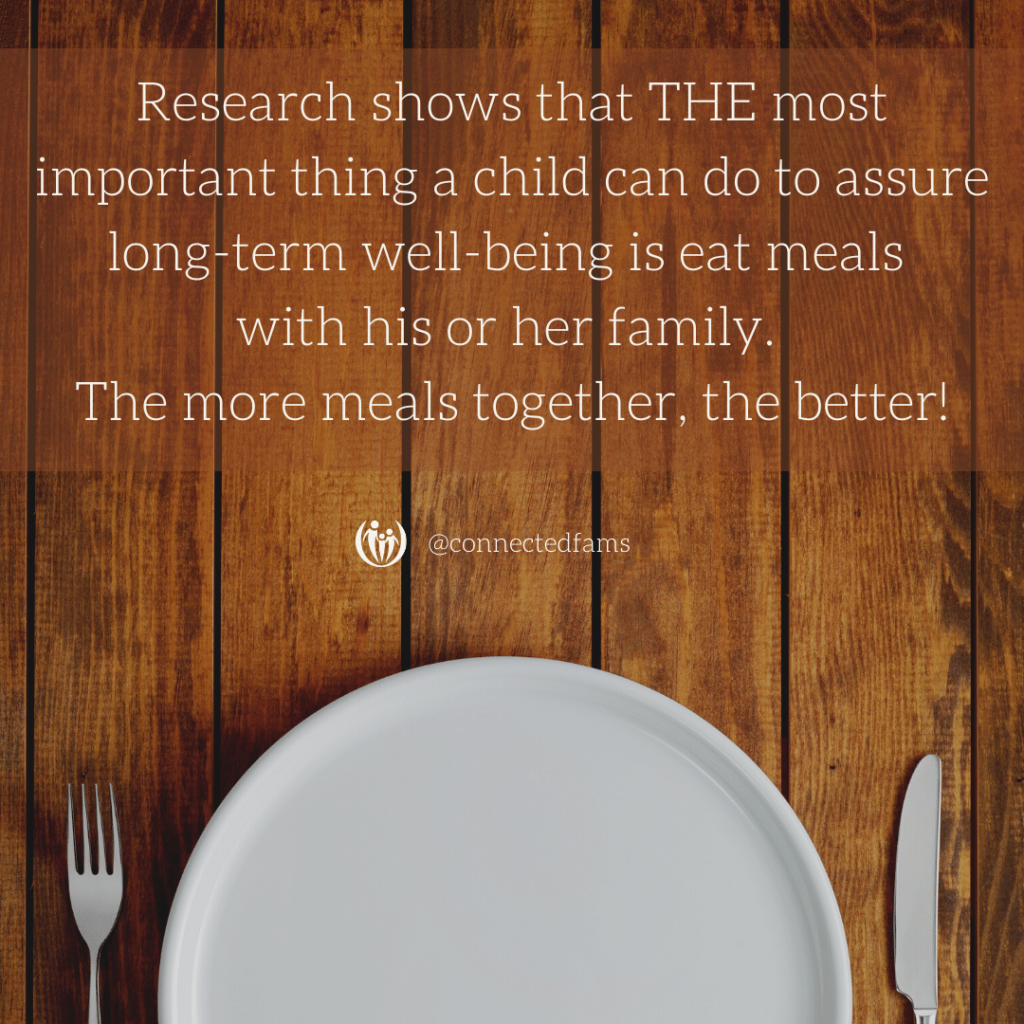
Struggling at the Family Dinner Table? How to Come Together & Enjoy

Did you know the most important piece of furniture in your home might be the family dinner table? And the quality of construction doesn’t matter. It’s all about the quality of connection you and your children cultivate over the years around the family dinner table (or kitchen island, etc.).
Of course, let’s be honest: the family dinner table might also be one of the most difficult places in your house. It’s where toddlers throw chicken noodle soup at the wall, siblings get into arguments, and your food-sensitive child screams in protest because they no longer like last week’s favorite food. 🤦♀️ If you don’t look at the table and look forward to your family’s next meal there, it’s okay. In fact, this is natural and to be expected.
Of course, this will be one place where you should expect a battle…. a battle not just of power struggles with cranky kids but a spiritual battle with Satan, who wants to rob you of this rich connection and influence with your children!
After all, connective and peaceful meals, where you discuss God and life’s struggles, are an important part of the heritage God gives you to pass down to your kids. If life around the family dinner table doesn’t feel connective and peaceful right now, maybe that’s because the work you’re doing is so important. These meals have huge predictive value in a child’s future spiritual and mental health, as well as overall “success.”
Why are family meals together so important?
Dr. Bill Doherty, Director of the Marriage and Family Therapy program, University of Minnesota, has identified gathering around the dinner table as a key factor for kids’ well-being:
“The simple act of regularly sitting down together to share food and conversation is the most important thing parents can do to help their children grow up well.” (formatting ours)
In fact, according to Bruce Feiler, there’s almost no area of your child’s life that isn’t improved by consistently gathering around the family dinner table,
“A recent wave of research shows that children who eat dinner with their families are less likely to drink, smoke, do drugs, get pregnant, commit suicide, and develop eating disorders. Additional research found that children who enjoy family meals have larger vocabularies, better manners, healthier diets, and higher self-esteem. The most comprehensive survey done on this topic, a University of Michigan report that examined how American children spent their time between 1981 and 1997, discovered that the amount of time children spent eating meals at home was the single biggest predictor of better academic achievement and fewer behavioral problems. Mealtime was more influential than time spent in school, studying, attending religious services, or playing sports.” (as quoted here)
(If you’re interested in diving deeper into the research behind family dinners, you might check out The Family Dinner Project.)
It is around the table that families connect and hear each other’s stories. It is around the family dinner table that our faith and values are passed from generation to generation. This has been true for centuries, but in the last generation, it is becoming increasingly common to not gather around the table to share conversation and food. And it is likely one reason our kids may be feeling more stressed out, anxious, and disconnected.
So how can we honor this age-old principle for passing faith and values over a meal? From a practical standpoint, what does the family dinner table look like?

Here is how one busy family gathers around the dinner table
Jan and Dean are a fairly typical family. Passing their faith and values to their kids is important to them, but they lead very busy lives. Jan and Dean are both self-employed, and their three kids are all involved in various extracurricular activities. Just coordinating pick-ups, drop-offs, carpools, and some fashion of nutrition requires a Herculean effort. Until recently, meals were often eaten in the car or in drive-by fashion at the kitchen counter during transitions.
Feeling committed to both the extracurricular activities and the sharing of meals, the family made a plan together. Side note: it’s really great to do this with the kids and not to them, perhaps at a family meeting.
Jan and Dean provide after-school snacks that are filling, which eliminates the need for dinner at their usual 6 pm time. They gather at 7:30 or 8:00 (when the kids wrap up their activities) and share a light supper together, catching up on the highlights of the day and taking time to discuss important life lessons.
During a recent 8 pm family supper, while the family shared a fun conversation, the question was posed, “What was your favorite time of the day?” One child was quick to answer, “My favorite time is right now!” The other kids chimed in with their agreement.
Mission accomplished! The kids enjoy the time together and are embracing their parents’ values.
Update: This story was originally published several years ago. We know this family well, and their kids (two of whom are now in college) still love to share dinners with their parents and any adult who happens to join them. And they have grown into delightful, compassionate, and responsible kids who definitely share their parents’ values!
How to make the most of your time around the family dinner table
Once you figure out a schedule for meals and get the family corralled at the dinner table, how can you maximize the impact of those times? How can you pass the values and faith while you pass the veggies and bread?
Technology has brought media and your kids’ peers into your home and your kids’ pockets nearly 24-7. If you aren’t thoughtful about how to be the strongest, clearest “voice” in this barrage of influences, someone else will raise your kids. And there’s a good chance they won’t share your values.

Family meals provide the perfect opportunity to share experiences and discuss values with your children. Here are four practical tips for meaningful mealtime connection:
1. Work together to plan and create the meal.
Use meal prep to start passing values before the food is even on the table. When kids help prepare a meal, it builds the value of healthy eating as well as serving others. When you express your appreciation for the help, it sets the stage for warm interaction at the table.
2. Avoid power struggles and reprimands.
Jesus ate with a wide variety of people without bringing up their past (Luke 7:34). Apparently, Jesus didn’t use dinners as a time to address his companions’ sins because they kept wanting to join him. A connective tone is essential for passing values during dinner. The family dinner table is not the time to bring up the D’s on Junior’s report card or require him to down those Brussels sprouts! As much as possible, focus on positive connection rather than reprimands and reminders.
3. Turn off the screens.
Many families try to kill two birds with one stone by eating and catching up on the news or a favorite show during mealtime. However, this is almost always counterproductive to connecting as a family. It’s vitally important to create a “distraction-free” zone. When parents are the first to put their phones in the “time-out basket” and turn off the TV, it makes a strong statement that everyone at the table is valuable and worth listening to. Especially if parents occasionally verbalize that very belief.
4. Don’t be afraid to dive in deep! (THE BEST PART)
A classic dinner table question is, “What was the highlight of your day?” which is essentially asking, “What circumstance made you happy today?” This makes for fun conversation, but without deeper perspectives, it can reinforce the notion that circumstances control our mood.
Consider adding questions that will deepen the discussion and strengthen character qualities.
A few of our favorite dinnertime questions:
- “When were you peaceful even though things didn’t go your way today?”
- “When did you work hard at something that was tough?”
- “What was the bravest thing you did today?”
- “Who were you kind to today?”
- “Who did you encourage?”
- “What was your favorite thing that you learned today?”
- “Was there a time today when you remembered how much God loves you?”
- “How were you a blessing to someone today?”
- Or try one of these 84 starter questions from Connected Families you can use anytime
Over the years, these meaningful mealtime discussions will impact your kids’ values in profound ways, even though it might feel awkward at times to talk about character and faith. Trying to dump your thoughts and ideas about faith on your kids will set off the lecture-alert bells in their brains. Instead, keep asking relaxed, non-trapping questions about their thoughts and ideas. Or set the stage with some honesty of your own about a spiritual struggle you have.
Parents, YOU are the most important people in your kids’ lives. If life circumstances have kept your family from enjoying meals as often as you’d like, try keeping it simple with just 2-3 family meals a week. Mealtime doesn’t have to be long and complicated—sometimes short and sweet is what works! Try giving it a shot and claim the rich heritage Jesus shows us of connecting well during meals.
Eat, relax, connect, and pass the values!

Do you have a child with EXTRA needs?
Parenting isn’t easy, but when you’ve got an extra INTENSE or SENSITIVE child with big feelings… it’s even harder.
The Sensitive and Intense Kids online course will equip you to parent well, even with these unique kiddos.




